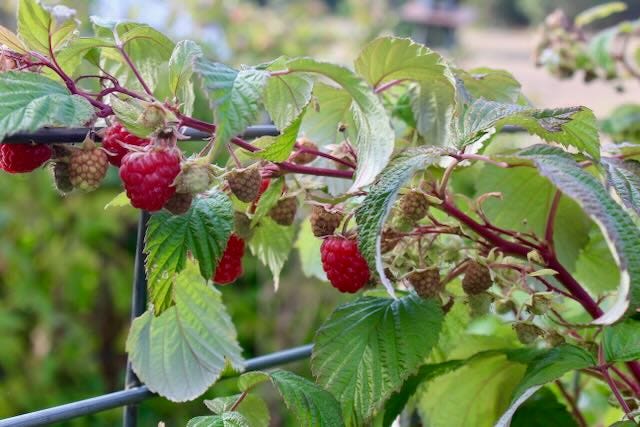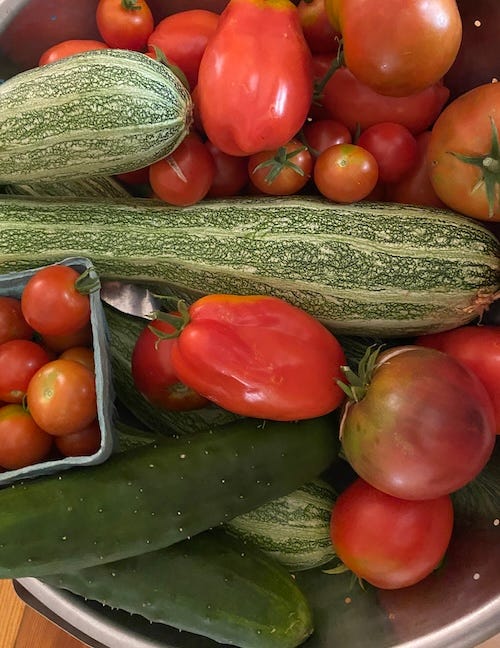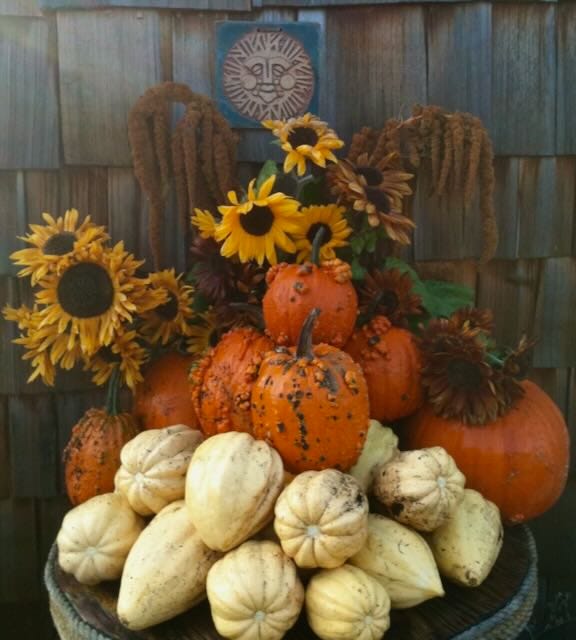I confess that one of my obsessions is food. I think about it every day of the year. I eat it, grow it, and preserve it. I read about it (don’t even ask how many cookbooks I have) and occasionally write about it. I traded my predictable suburban life for an unpredictable rural homestead kind of life partly because I wanted to spend more time growing food and medicinal herbs. When I think about my valued assets, I start with my knowledge and experience in growing and cooking food. If the shit hits the fan, I will be out in the garden.
Eating with the fullest pleasure — pleasure, that is, that does not depend on ignorance — is perhaps the profoundest enactment of our connection with the world.
Wendell Berry, The Pleasures of Eating
My journey with food has been expansive, experimental, and delightfully delicious. My childhood meals had little fresh produce; my mom loved to stock her pantry with commercially canned vegetables and boxes of processed ingredients designed to be mixed with ground beef for an easy and quick casserole. She cooked traditional holiday meals twice yearly, but most of her energy was devoted to sweet desserts. My mom had a wicked sweet tooth that eventually contributed to a diagnosis of diabetes.
After my son was born in 1982, I decided to make all his baby food from scratch, which ignited my curiosity about food and nutrition. In the 1990s, I taught myself how to grow food, learning primarily from many failures and the occasional successes. I went through phases of vegetarianism, a few days of veganism, and several weeks of keto, and now I am back where I began—eating a Mediterranean-style diet.
Growing a portion of my food each year expanded my knowledge about the mounting problems with industrialized agriculture and the global food economy. I am fortunate to be in the PNW, which has an abundance of traditional and new food traditions.
Building a Regional Food System
My region is rich in agricultural history: hundreds of orchards, vast wheat fields, and, more recently, wine grapes and market farmers. Five small towns host thriving farmers' markets within the 90-mile canyon of the Columbia River Gorge that separates Oregon and Washington. In 2010, Gorge Grown Food Network, a non-profit organization, was formed with the following mission:
GGFN aims to build an inclusive, resilient regional food system that improves the health and well-being of our community.
This organization has helped our local food economy grow. It is sustained by supporting small farmers, ranchers, and orchardists, maintaining access to locally grown food through various retail strategies, securing USDA funding that makes local fresh food more affordable, and monitoring food security in our region. They have introduced a robust Veggie RX prescription program that utilizes healthcare providers who screen for food security with their patients and “prescribe” fresh produce. They recommend those who would benefit from more affordable access to fresh produce. It’s a win-win-win solution for consumers, farmers, and our healthcare system. (Many states have at least one Veggie Rx program; search your state to see who has received funding.)
Benefits of Locally-Grown Food
Before refrigeration, the interstate system, industrialized agriculture, and global markets, our food came from our backyards and local farms. The modernization of our food system has had profound impacts that are too numerous to discuss in this essay. In this newsletter, I want to discuss the abundance of harvest season and the benefits of locally grown food.
Local Food Is More Nutritious & Free of Toxins
Over the last three decades, media articles suggested that the carrots our grandmothers ate were more nutritious than the conventionally grown ones now sold in grocery stores. Multiple factors contributed to what is sometimes called a nutrient collapse.
One theory asserts that industrial agriculture has gradually depleted the soil of its minerals and nutrients and focused on synthetic fertilizers and pesticides to produce fast-growing vegetables that look “healthy.” However, there isn’t enough conclusive research to support this notion fully. But we are learning much about how important soil health is for food crops. As we learn more about the soil microbiome, we recognize the complex relationships between bacteria, viruses, and fungi, how they contribute to plant health, and their ability to help plants uptake nutrients from the soil. Industrial agriculture's use of toxins contributes to the death of soil microbiomes.
Small farms and home gardeners lean toward organically grown strategies, including regenerating the soil by constantly adding organic matter like manure, cover crops, and compost. For most of agriculture’s history, this was the traditional way of improving and maintaining soil health.
Another factor involves seed selection and modification. Since the 1950s, plant breeders have modified crops to serve the demands of industrialized agriculture, focusing on yield, uniform appearance, ease of transport, and more extended storage.
The produce in our grocery stores travels an average of 1500 miles from farm to store. Shipping produce from other parts of the country and the world requires growers to pick it four to seven days before it is ripe. Despite careful packaging and refrigeration, most produce loses significant nutritional value—as much as 50% for some crops—when placed in grocery stores. Local growers harvest the day before the market or CSA delivery to ensure ripeness, freshness, and nutritional quality.
Locally raised and pastured meat doesn’t use additional antibiotics like factory-farmed meat. Studies show that grass-fed beef, often available from local sources, has a higher amount of omega-3s, a beneficial fat that aids in brain function. Animals raised in industrial agriculture live unnatural lives and often under inhumane conditions. A local rancher I buy meat from told me that his animals’ last day is the only bad day they have in their lives.
Local Food is More Diverse & Tastes Better
Step into a grocery store's produce department, and you will usually find two kinds of lettuce, one type of carrot, two kinds of onions, and one or two kinds of potato—selections designed to travel many miles and still look good in the market weeks after the crops were picked. How they taste is not part of the profit equation.
Open a seed catalog and let the drooling begin! The world of vegetables, fruits, and grains is colorful and diverse. I learned that purple potatoes, carrots, and cauliflower have more antioxidants than less colorful cousins. I grow new cultivars each year to experiment and see what does well in my 2400 ft. elevation garden. The diversity of open-pollinated and heirloom cultivars often looks and tastes differently than grocery store standard stock.
Stroll through a farmer’s market, and you cannot predict what you will find. Local growers select crops for a variety of reasons: adaptation to geographical regions, long harvest season, exceptional taste, unusual colors, rarity, and, for some, unusual physical traits that can persuade a grower to give them a try. This interest in crop diversity, in turn, supports genetic diversity, keeping open-pollinated seeds in the food system.
Local Food Empowers Regional Food Access & Security
Aside from these benefits, buying locally grown food supports regional farms and your local economy. During the pandemic, we saw how easily our supply chains can be affected. Remember the toilet paper shortage? Each winter, our interstate and state highways close because of hazardous weather conditions, and our one small grocery store empties of produce, bread, eggs, and dairy within a day or two.
Despite all the food grown in the US, food deserts are increasing in urban and rural areas. A food desert is a community that lacks access to healthy food. In rural areas, shoppers may only have one small market selling shelf-stable processed food or drive several hours to a bigger store. In urban settings, corner stores sell alcohol, cigarettes, junk food, and giant sodas rather than fresh produce.
There are a few challenges to buying locally-produced food:
Local food is regional and seasonal, so if you want oranges and bananas in the PNW, you will have to shop at a grocery store. Eating seasonally is a transition and requires a willingness to limit your menu. Most of us have lived in a food economy full of abundance and diversity.
Markets and stands have limited hours of operation, which is why grocery stores are so convenient.
The biggest complaint about buying local produce is that it can be more expensive than produce in a grocery store chain. This is often true because industrial agriculture relies on cheap labor, paying migrants to harvest and process our food well below a livable wage.
Cheap food is an illusion. There is no such thing as cheap food. The real cost of the food is paid somewhere. And if it isn't paid at the cash register, it's charged to the environment or to the public purse in the form of subsidies. And it's charged to your health.
Michael Pollan, Writer
Seniors and Food Insecurity
Feeding America recently estimated that over 12 million Americans aged 50 and older struggle to afford food. Since the pandemic, food costs have risen by 20% while food corporations have experienced record-setting profits. Congress reauthorizes the Farm Bill every five years, which usually includes funding for multiple programs that provide nutritional assistance for low-income Americans. One of these programs is the Seniors Market Farmers Nutrition Program, which offers financial aid to purchase locally-grown produce from farmers' markets, farm stands, and CSAs. Check this link to see if your state has secured funding and where it can be used.
Kentucky farmer and acclaimed writer Wendell Barry wrote, “Eating is an agricultural act.” Choosing to buy a portion or all of your food at a local farmers’ market, through a CSA, or from a meat producer is an opportunity to vote for a food system that supports regional growers and ranchers, nurtures a local economy, is kinder to the environment, assures high nutritional quality, and delights in diversity and exceptional taste.

Locally grown food is gaining in the market, though slowly, and can be found in the following places:
Farmers’ Markets
Farm Stands, Stores, Co-ops, and Stops
Farm Share/Community Supported Agriculture
Home gardens
Preserving Summer’s Abundance
As my garden yield increased, I had to learn how to preserve it for winter use. Freezing is easy but can be a disaster if I lose power for several days. I have turned to dehydrating and canning. Like my mother, I enjoy a well-stocked pantry and feel a sense of gratitude and pride when I have grown and preserved some of what’s in the pantry. Below are some of my favorite items to preserve:
Pesto
Pick up several bunches of basil and parsley, garlic, nuts or seeds of your choice, and Parmesan cheese, and make several batches of pesto in a food processor. I freeze each batch in ice-cube trays. I use them to flavor soups, sauces, and, of course, to make a quick pasta dish.
Grilled Vegetables
One of the easiest ways to enjoy summer’s vegetable abundance in winter is to chop your favorite vegetables (red/green bell peppers, onion, summer squash, eggplant, carrots, etc.), drizzle them with balsamic vinegar and olive oil, and either grill them in a basket or roast them on a sheet pan. Let them cool, and package them into freezer containers. I use these to make a quick soup, veggie tacos, or burritos and as a vegetable choice for dinner. Tip: Make a lot!
Cowboy Candy
Candied Pickled Jalapenos are easy to make and delicious on burgers, tacos, or burritos with crackers and cream cheese. I canned 20 small jars for the winter. The recipe below does not require canning—store it in the fridge.
Fermented sour pickles
I make a gallon of these yearly. Once fermented to your preferred taste, store them in the fridge. There are many simple recipes online. Fermented foods are good for our gut biomes.
Refrigerator pickles
I love pickles! I grow pickling cukes and never seem to have enough. This recipe makes the crunchiest pickles.
Thank you for being here. All of my posts are free, but if you’d like to support my work, you can do so by:
Liking and restacking this post so others are encouraged to read it.
Share this post via email or on social media.
Taking out a paid subscription to this Substack.
Your turn - share a favorite recipe to preserve summer’s abundance. Tell us about your community’s access to locally-grown food or lack of it.








You make a powerful case for the many benefits of supporting local growers. Thanks for explaining all those advantages. Our choices have profound implications for the short- and long-term heallth of our planet.